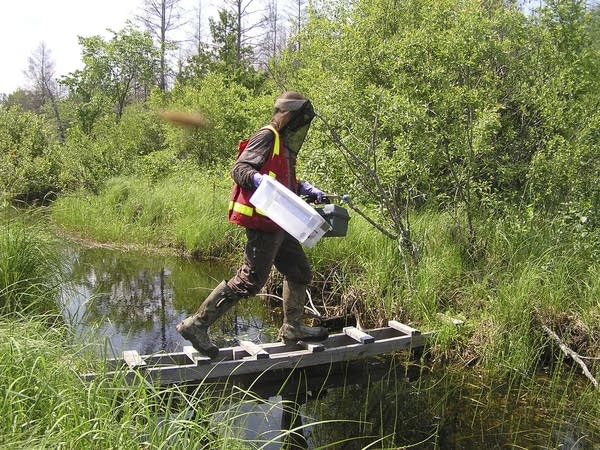Climate change might be enabling beetles' rise against pine trees
Go Deeper.
Create an account or log in to save stories.
Like this?
Thanks for liking this story! We have added it to a list of your favorite stories.

Minnesota's coniferous trees are facing newly formidable foes: beetles.
Stately, tall white pines all over the state and the tamaracks of northeastern Minnesota have had their natural defenses from beetles weakened. Scientists suspect climate change is to blame in both cases.
Turn Up Your Support
MPR News helps you turn down the noise and build shared understanding. Turn up your support for this public resource and keep trusted journalism accessible to all.
The beetles' rise is proof that the transformation of Minnesota's forests isn't a simple matter of some tree species handling warmer temperatures better than others. It's the result of changes happening throughout a complex ecosystem.
DROUGHT WEAKENS WHITE PINE
White pines have a lot of pitch, or resin, which acts like an anti-beetle defense system. Typically, bark beetles aren't seen often in white pine during a drought.
But Department of Natural Resources forest health specialist Ryan Blaedow said the agency has counted hundreds of white pines from the Twin Cities to Hinckley to St. Cloud with their top six to 10 feet killed.

"I'm seeing it pretty widespread, across the central portion of the state, but if you look hard enough you can pretty much find it anywhere in the state," Blaedow said.
The DNR is conducting aerial surveys of trees over the entire state, and will know later this summer more precisely how many pines are under attack by beetles.
Scientists surmise the severe drought of the last couple summer has weakened white pine defenses.
When a beetle first arrives and bores into a tree's bark, the insect releases a chemical — what scientists call an aggregation pheromone — that in turn attracts other beetles, like a battle general calling in reinforcements. So while a tree may be able to fend off a few beetles, it can't survive a full scale invasion.
"Death by a thousand cuts," is how Brian Aukema, a forest entomologist at the University of Minnesota, describes it.
EASTERN LARCH BEETLE DEVASTATES TAMARACKS
For the past decade, the eastern larch beetle has killed thousands of tamarack trees in the forested bogs of far northern Minnesota.
University of Minnesota Ph.D student Fraser McKee spends 10 hours a day sloshing through the Beltrami Island State Forest, just a few miles south of Lake of the Woods along the Canadian border. Sunlight filters in through tamarack and cedar branches. Mosquitos form a thick, buzzing fog. For protection, McKee wears netting over his head and arms, latex gloves, and three shirts, despite temperatures near 90.

"If you give them much attention they'll drive you half nuts by the end of the day," McKee said of the mosquitoes.
About a million acres of tamarack trees grow in Minnesota, mostly in buggy bogs like this one. But since 2000, the eastern larch beetle has wiped out 15 percent of them. It's only the third major outbreak of the beetle ever recorded in North America. And its spreading to Wisconsin, Michigan and Canada.
McKee uses a saw to expose the inner bark and the beetles' attack points. He places colored pins over each tiny bore hole, like a road map of beetle attacks.
The bugs feast on the tree's inner bark. Then the females lay eggs. After about a month, fully grown black beetles emerge, each about 4 millimeters long.

Past studies have shown these newly born beetles will not attack trees and lay their own eggs until the following year. But McKee, for the first time, has found these young beetles will in fact infest new trees the same summer they hatch. He suspects that's what's driving the outbreak in Minnesota.
"It does open up the window for more tree mortality every year, more beetle reproduction, which is going to keep the populations higher which means more beetle pressure in the stand," McKee said. "It's going to let those beetles really overwhelm these trees and overwhelm the defense system of the tree."
McKee and his adviser Brian Aukema suspect that historically, the newly hatched eggs received a cold temperature cue, telling them to wait until after the winter to lay their eggs. They need to do more research, but climate data suggests earlier springs and later falls are interfering with the beetles' behavior.
ANOTHER THREAT ON HORIZON
Meanwhile, an even bigger threat seems to be approaching. The mountain pine beetle, the bug responsible for massive tree kills in the West, is on the move. Aukema said it's jumped the northern Rockies into the jack pine forest of Alberta, Canada. That forest stretches all the way east to Minnesota and beyond.
"All the signs we're seeing as is it's started its progression through the Canadian boreal forest to Minnesota, it's not looking very good," Aukema said.
Aukema said in the past only two things have interrupted the gorging beetles: really cold temperatures, or, they eventually run out of pine trees.
Dear reader,
The trustworthy and factual news you find here at MPR News relies on the generosity of readers like you.
Your donation ensures that our journalism remains available to all, connecting communities and facilitating better conversations for everyone.
Will you make a gift today to help keep this trusted new source accessible to all?







